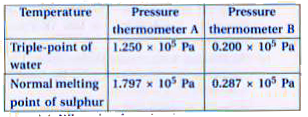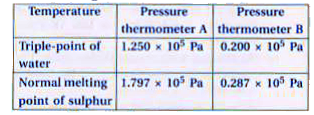Two ideal gas thermometer A and B use oxygen and hydrogen respectively . The following observations are made:
Temperature,
Pressure therometer A,
Pressure therometer B
Triple point of water,
1.250×105Pa,
0.200×105Pa
Normal melting point of sulphur, 1.797×105Pa,
0.287×105Pa
(a) What is the absolute temperature of normal melting point of sulphur as read by thermometers A and B ?
(b) What do you think is the reason for the slightly different answers from A and B ? (The thermometers are not faulty). what further procedure is needed in the experiment to reduce the discrepancy between the two readings. Solution in Tamil
(a) TΛ=392.69K,TB=391.98K, (b) The discrepancy arises because the gases are not perfectly ideal To reduce the discrepancy. readings should be taken for lower and lower pressures and the plot between temperature measured versus absolute pressure of the gas at triple point should be extrapolated to obtain temperature in the limit pressure tends to zero, when the gases approach ideal gas behaviour.
Topper's Solved these Questions
- THERMAL PROPERTIME OF MATTERBOOK - NCERT TAMILCHAPTER - THERMAL PROPERTIME OF MATTEREXERCISE - EXERCISES
31 Videos
- SYSTEMS OF PARTICLES AND ROTATIONAL MOTIONBOOK - NCERT TAMILCHAPTER - SYSTEMS OF PARTICLES AND ROTATIONAL MOTIONEXERCISE - EXERCISES (TRUE OR FALSE)
5 Videos
- THERMODYNAMICS BOOK - NCERT TAMILCHAPTER - THERMODYNAMICS EXERCISE - EXERCISES
10 Videos
Similar Questions
The triple point of neon and carbon dioxide are 24.57K and 216.55K respectively. Express these temperature on the Celsius and Fahrenheit scales.
View SolutionRead each statement below carefully and state with reasons, if it is true ot false. (a) During rolling the force of friction acts in the same direction as the direction of motion of c.m of the body. (b) The instantaneous speed of the point of contact during rolling is zero. (c ) The instantaneous acceleration of the point of contact during rolling is zero. (d) For perfect rolling motion, work done against friction is zero. (e) A wheel moving down a perfectly frictionless inclined plane will undergo slipping (not rolling motion).
View SolutionA boiler heats water flowing at the rate of 2,0 litres per minute from 27°C to 77°C. If the boiler operates on a gas burner, the rate of consumption of the fuel if its heat of combustion is 4.0×104J/g , is
View SolutionA mixture of hydrogen and oxygen gas weighing 0.76g has volume 2 liter temperature 300K and pressure 100 kPa Calculate masses of hydrogen and oxygen in gas mixture Assume ideal nature .
View SolutionTwo ideal gas thermometer A and B use oxygen and hydrogen respectively . The following observations are made:
Temperature, Pressure therometer A, Pressure therometer B
Triple point of water, 1.250×105Pa, 0.200×105Pa
Normal melting point of sulphur, 1.797×105Pa, 0.287×105Pa
(a) What is the absolute temperature of normal melting point of sulphur as read by thermometers A and B ?
(b) What do you think is the reason for the slightly different answers from A and B ? (The thermometers are not faulty). what further procedure is needed in the experiment to reduce the discrepancy between the two readings.
View SolutionA temperature T is measured by a constant volume gas thermometer (i) T is independent of the gas used at all pressure (ii) T is independent of the gas used only at low pressure (iii) The ideal gas scale agrees with the absolute scale of temperature (iv) The ideal gas scale does not agrees with the absolute scale of temperature
View Solutionदो आदर्श गैस तापमापियों A तथा B में क्रमशः ऑक्सीजन तथा हाइड्रोजन प्रयोग की गयी है | इनके प्रेक्षण निम्नलिखित है :

(a) दो आदर्श गैस तापमापियों A तथा B में क्रमशः ऑक्सीजन तथा हाइड्रोजन प्रयोग की गयी है | इनके प्रेक्षण निम्नलिखित है :
(b) आपके विचार से तापमापियों A तथा B के उत्तरों में थोड़ा अंतर होने का क्या कारण हैं ? (दोनों तापमापियों में कोई दोष नहीं है ) | दो पाठ्यांको के बीच की विसंगति को कम करने के लिए इस प्रयोग में और क्या प्रावधान आवश्यक है ?
View Solutionदो आदर्श गैस तापमापियों A तथा B में क्रमशः ऑक्सीजन तथा हाइड्रोजन प्रयोग की गई है। इनके प्रेक्षण निम्नलिखित है-

(i) तापमापियों A तथा B के द्वारा लिये गये पाठ्यांको के अनुसार सल्फर के सामान्य गलनांक के परमताप क्या है?
(ii) आपके विचार से तापमापियों A तथा B के उत्तरो में थोड़ा अन्तर होने का क्या कारण है? (दोनों तापमापियों में कोई दोष नहीं है) दो पाठ्यांको के बीच की विसंगति को कम करने के लिए इस प्रयोग में और क्या प्रवाधान आवश्यक है?
View SolutionTwo separate bulbs contain ideal gases A and B respectively. The density of gas A is twice that of gas B and the molar of gas A is half that of gas B. If two gases are at the same temperature, the ratio of pressure of A to that of B is:
View SolutionTwo ideal gas thermometers A and B use oxygen and hydrogen respectively. The following observations are made: {:("Temperature","Pressure","Pressure"),(,"thermometer A","thermometer B"),("Triple - point water",1.250 xx10^(5) Pa,0.200 xx 10^(5) Pa),("Normal melting point of sulphur",1.797 xx10^(5)Pa,0.287 xx10^(5)Pa):} (a) What is the absolute temperature of normal melting point of sulphur as read by thermometers A and B ? (b) What do you think is the reason behind the slight difference in answers of thermometers A and B ? (The thermometers are not faulty). What further procedure is needed in the experiment to reduce the discrepancy between the two readings ?
View SolutionTwo ideal gas thermometers A and B use oxygen and hydrogen respectively. The following observations are made:
TemperaturePressurePressurethermometer Athermometer BTriple - point water1.250×105Pa0.200×105PaNormal melting point of sulphur1.797×105Pa0.287×105Pa
(a) What is the absolute temperature of normal melting point of sulphur as read by thermometers A and B ?
(b) What do you think is the reason behind the slight difference in answers of thermometers A and B ? (The thermometers are not faulty). What further procedure is needed in the experiment to reduce the discrepancy between the two readings ?
View SolutionTwo ideal gas thermometers A and B use oxygen and hydrogen respectively. The following observations are made: {:("Temperature","Pressure","Pressure"),(,"thermometer A","thermometer B"),("Triple - point water",1.250 xx10^(5) Pa,0.200 xx 10^(5) Pa),("Normal melting point of sulphur",1.797 xx10^(5)Pa,0.287 xx10^(5)Pa):} (a) What is the absolute temperature of normal melting point of sulphur as read by thermometers A and B ? (b) What do you think is the reason behind the slight difference in answers of thermometers A and B ? (The thermometers are not faulty). What further procedure is needed in the experiment to reduce the discrepancy between the two readings ?
View SolutionTwo ideal gas thermometers A and B use oxygen and hydrogen respectively. The following observations are made:
TemperaturePressurePressurethermometer Athermometer BTriple - point water1.250×105Pa0.200×105PaNormal melting point of sulphur1.797×105Pa0.287×105Pa
(a) What is the absolute temperature of normal melting point of sulphur as read by thermometers A and B ?
(b) What do you think is the reason behind the slight difference in answers of thermometers A and B ? (The thermometers are not faulty). What further procedure is needed in the experiment to reduce the discrepancy between the two readings ?
View SolutionTwo ideal gas thermometer A and B use oxygen and hydrogen respectively . The following observations are made: Temperature, Pressure therometer A, Pressure therometer B Triple point of water, 1.250xx10^(5)Pa , 0.200xx10^(5)Pa Normal melting point of sulphur, 1.797xx10^(5)Pa , 0.287xx10^(5)Pa (a) What is the absolute temperature of normal melting point of sulphur as read by thermometers A and B ? (b) What do you think is the reason for the slightly different answers from A and B ? (The thermometers are not faulty). what further procedure is needed in the experiment to reduce the discrepancy between the two readings.
View SolutionTwo ideal gas thermometers A and B use oxygen and hydrogen respectively. The following observations are made :

What is the absolute temperature of normal melting point sulphur as read by thermometers A and B ?
View SolutionTwo ideal gas thermometers A and B use oxygen and hydrogen respectively. The following observations are made :

What do you think is the reason behind the slight difference in answers of thermometers A and B ? (The thermometers are not faulty). What further procedure is needed in the experiment to reduce the discrepancy between the two readings ?
View Solution
